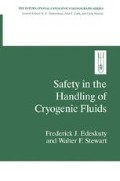Abstract
Although slush hydrogen has been studied for about three decades, its use on a larger scale has become of greater interest because of its importance to aerospace applications such as the National Aero-Space Plane (NASP). This chapter discusses briefly the properties and characteristics of slush hydrogen that can influence the safety of its handling, the nature of potential safety hazards arising from these properties, and the design and operational considerations needed to make safe the operation of slush-hydrogen systems.1 In some cases, the safe handling of slush hydrogen will require the further elucidation of some safety problems. A discussion of safety problems that need further research, either analytic or experimental, or both, is given in Chapter 12.
Access this chapter
Tax calculation will be finalised at checkout
Purchases are for personal use only
Preview
Unable to display preview. Download preview PDF.
References
Edeskuty, F. J., Stewart, W. F., and Mann, D. B. (1991). Slush Hydrogen Safety, NASP Technical Memorandum 1145, NASA Langley Research Center, Langley, Virginia.
Roder, H. M. (1977). The Thermodynamic Properties of Slush Hydrogen and Oxygen, NBSIR 77-859, U.S. National Bureau of Standards, Boulder, Colorado.
McCarty, R. D., Hord, J., and Roder, H. M. (1981). Selected Properties of Hydrogen (Engineering Design Data), NBS Monograph 168, U.S. Department of Commerce/U.S. National Bureau of Standards, Washington, D.C.
Mullins, J. C, Ziegler, W. T., and Kirk, B. S. (1961). The Thermodynamic Properties of Parahydrogen from 1 to 22 K, Technical Report No. 1, Project No. A-593, Engineering Experiment Station, Georgia Institute of Technology, Atlanta, Georgia.
Willis, W. L. (1966). Electrical conductivity of some cryogenic fluids, Cryogenics 6 (October), 279.
Scott, R. B. (1988). Cryogenic Engineering, Met-Chem Research Inc., Boulder, Colorado.
Scott, R. B., Brickwedde, F. G., Urey, H. C, and Wahl, M. H. (1934). J. Chem. Phys. 2, 454.
Farkas, A. (1935). Orthohydrogen and Heavy Hydrogen, Cambridge University Press, Cambridge, England.
Greene, N. E., and Sonntag, R. E. (1968). Solid-liquid-vapor equilibrium in the system hydrogen-helium, in Advances in Cryogenic Engineering (K. D. Timmerhaus, ed.), Vol. 13, pp. 357–362, Plenum Press, New York.
Smith, S. R. (1952). Gas-Liquid Phase Equilibrium in the He-H2 System, Ph.D. Thesis, Ohio State University, Columbus, Ohio.
Street, W. B., Sonntag, R. E., and Van Wylen, G. J. (1964). Liquid-vapor equilibrium in the system normal hydrogen-helium, J. Chem. Phys. 40, 1390.
Laquer, H. L. personal communication.
Edeskuty, F. J., and Williamson, K. D., Jr. (1977). Liquid hydrogen storage and transmission, in Hydrogen: Its Technology and Implications (K. E. Cox and K. D. Williamson, Jr. eds.), Vol. II, Chap. 3, CRC Press, Boca Raton, Florida.
Gu, Y., and Timmerhaus, K. D. (1994). Experimental verification of stability characteristics for thermal acoustic oscillations in a liquid helium system, in Advances in Cryogenic Engineering (P. Kittel, ed.), Vol. 39, pp. 1733–1748, Plenum Press, New York.
Ludtke, P. R. (1970). Slush Hydrogen Flow Facility, U.S. National Bureau of Standards Report 9752, Boulder, Colorado.
Arthur D. Little, Inc. (1961). Final Report, Electrostatic Hazards Associated with the Transfer and Storage of Liquid Hydrogen, Report to the Agena and Centaur Systems Office, Marshall Space Flight Center, National Aeronautics and Space Administration, Huntsville, Alabama.
Mann, D. B., Ludtke, P. R., Sindt, C. F., Chelton, D. B., Daney, D. E., and Pollack, G. L. (1965). Characteristics of Liquid-Solid Mixtures of Hydrogen at the Triple Point, U.S. National Bureau of Standards Report 8881, Boulder, Colorado.
Sindt, C. F. (1970). A summary of the characterization study of slush hydrogen, Cryogenics, 10(5), 372–380.
Voth, R. O. (1978). Producing liquid-solid mixtures of hydrogen using an auger, U.S. National Bureau of Standards Report NBSIR 78-875, Boulder, Colorado.
Voth, R. O., Ludtke, P. R., and Brennan, J. A. (1990). Producing slush hydrogen with a small auger, National Aero-Space Plane Technical Memorandum 1099, National Aeronautics and Space Administration Langley Research Center, Langley, Virginia.
Waynert, J. A., Barclay, J. A., Claybaker, C., Foster, R. W., Jaeger, S. R., Kral, S., and Zimm, C. (1988). Production of slush hydrogen using magnetic refrigeration, in Proceedings of the 7th Intersociety Cryogenics Symposium of the ASME, Houston, Texas, Jan. 22–25, 1989 (C. F. Gottzmann, L. C. Kun, K. D. Timmerhaus, and L. Wenzel, eds.), The American Society of Mechanical Engineers, New York.
Military Specification, Propellant, Hydrogen, MIL-P-27201B (1971).
Compressed Gas Association (1990). CGA G-5.3, Commodity Specification for Hydrogen, Compressed Gas Association, Arlington, Virginia.
Scott, L. E., Robbins, R. F., Mann, D. B., and Birmingham, B. W. (1960). Temperature stratification in a nonventing liquid helium Dewar, J. Res. 64C(1), 19.
Mann, D. B., Sindt, C. F., Ludtke, P. R., and Chelton, D. B. (1966). Slush Hydrogen Fluid Characterization and Instrumentation Analysis, U.S. National Bureau of Standards Report 9265, Boulder, Colorado.
Daney, D. E., Ludtke, P. R., Chelton, D. B., and Sindt, C. F. (1968). Slush Hydrogen Pumping Characteristics, U.S. National Bureau of Standards Technical Note 364, Boulder, Colorado.
Sindt, C. F., Ludtke, P. R., and Daney, D. E. (1969). Slush Hydrogen Fluid Characterization and Instrumentation, U.S. National Bureau of Standards Technical Note 377, Boulder, Colorado.
Author information
Authors and Affiliations
Rights and permissions
Copyright information
© 1996 Springer Science+Business Media New York
About this chapter
Cite this chapter
Edeskuty, F.J., Stewart, W.F. (1996). Slush Hydrogen. In: Safety in the Handling of Cryogenic Fluids. The International Cryogenics Monograph Series. Springer, Boston, MA. https://doi.org/10.1007/978-1-4899-0307-5_10
Download citation
DOI: https://doi.org/10.1007/978-1-4899-0307-5_10
Publisher Name: Springer, Boston, MA
Print ISBN: 978-1-4899-0309-9
Online ISBN: 978-1-4899-0307-5
eBook Packages: Springer Book Archive

